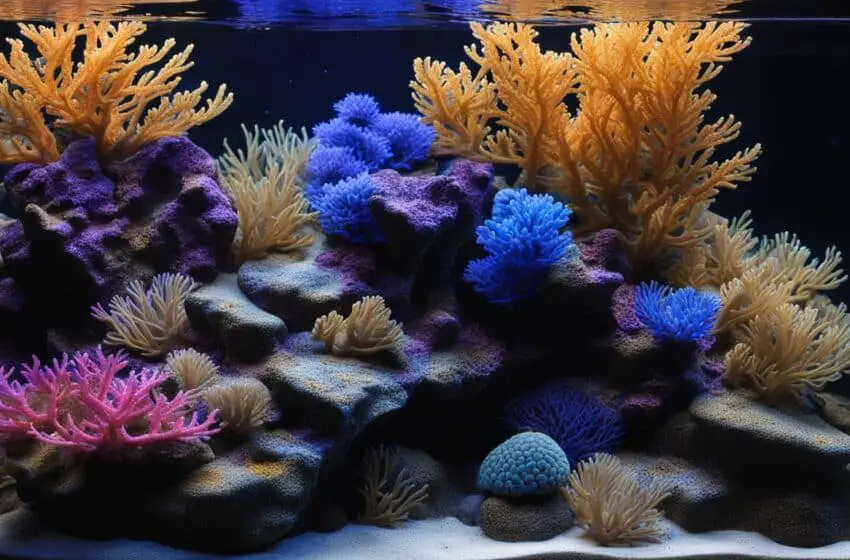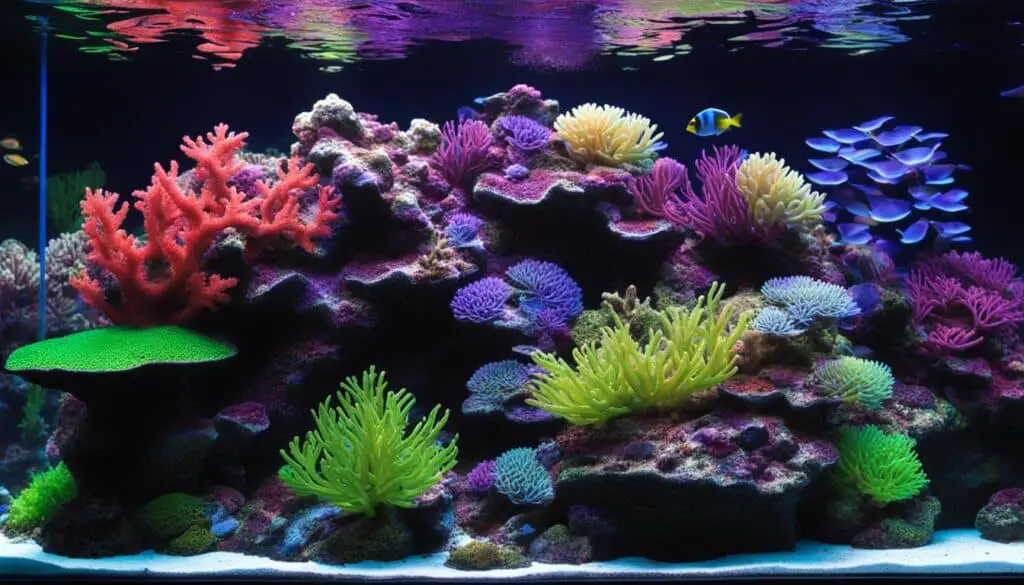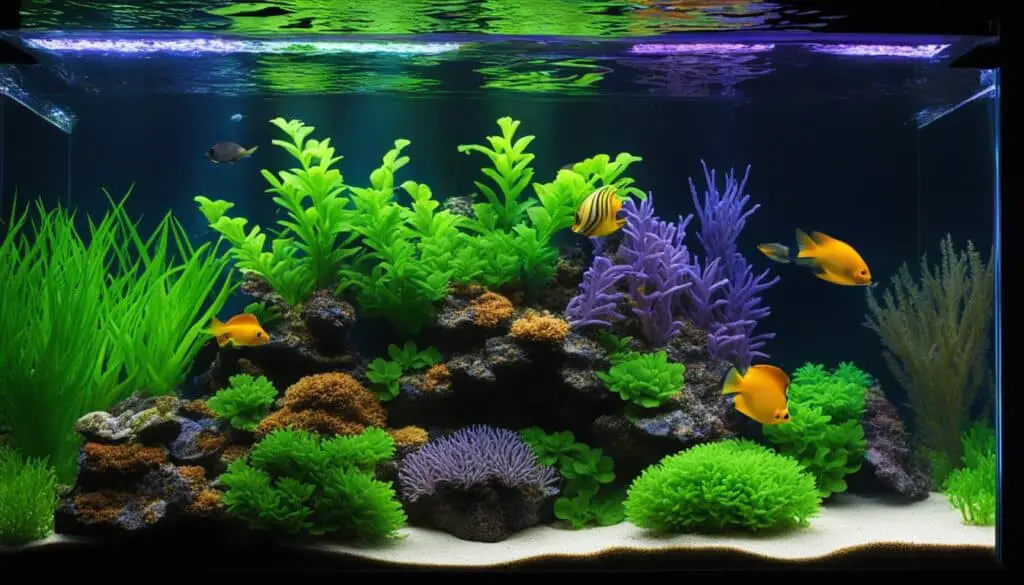Saltwater Aquarium Lighting: LED vs. T5 vs. Metal Halide

When it comes to lighting options for marine tanks, choosing the right solution is crucial to create a healthy and vibrant environment for your saltwater aquarium. LED, T5, and metal halide lighting are the three main options to consider. Each option has its own unique features and advantages, making it important to understand the differences and select the best fit for your marine tank.
LED lighting has gained popularity in recent years due to its advanced controllability and energy efficiency. LED fixtures offer a wide range of control options, allowing you to adjust the light output, spectrum, and timing to create the perfect lighting conditions for your marine life. They also consume less energy compared to T5 and metal halide fixtures, saving you money on electricity bills in the long run.
T5 lighting fixtures provide an even distribution of light, ensuring every corner of your aquarium receives sufficient illumination. With T5 fixtures, you can choose from a variety of color spectrum options by simply changing the bulbs. This flexibility allows you to create different lighting effects and enhance the visual appeal of your marine tank.
Metal halide lighting is known for its high light output and stunning shimmer effect. The intense light emitted from a single point source creates a mesmerizing sparkle in the water, resembling natural sunlight. However, metal halide fixtures produce more heat compared to LED and T5 fixtures, requiring proper heat dissipation measures to prevent overheating in your aquarium.
Key Takeaways:
- LED, T5, and metal halide are the main lighting options for saltwater aquariums.
- LED fixtures offer advanced controllability and energy efficiency.
- T5 fixtures provide even light distribution and a wide range of color spectrum options.
- Metal halide fixtures offer high light output and a stunning shimmer effect.
- Consider factors such as light output, color spectrum, heat, and energy consumption when selecting the lighting option for your marine tank.
Light Output and Distribution
When it comes to selecting the right lighting option for your saltwater aquarium, understanding the light output and distribution of different fixtures is essential. In this section, we’ll explore the characteristics of LED, T5, and metal halide lighting options, focusing on their light output and distribution.
Light Output
Light output refers to the amount of light emitted by a lighting fixture. Among the three options, high-wattage metal halides provide the highest light output, followed closely by T5 and LED fixtures. Metal halides are known for their ability to produce intense light, making them a popular choice for reef aquariums and tanks with light-demanding corals.
LED fixtures have also made significant advancements in their light output, offering a comparable level of brightness to T5 fixtures. However, it’s important to note that the specific wattage and design of LED fixtures can vary, which can impact their light output.
Light Distribution
The distribution of light is equally important in aquarium lighting. Uneven or poor light distribution can result in shadowed areas, affecting the overall appearance and health of your marine life. Let’s take a closer look at the light distribution of each lighting option.
T5 fixtures provide an even blanket of light with slight shadowing, ensuring a well-distributed illumination throughout the tank. This makes T5 lighting a popular choice for aquariums with diverse coral and fish species.
LED fixtures have improved their light distribution capabilities over time but still lag slightly behind T5 fixtures. While LEDs offer a more even light spread compared to metal halides, some shadowing or hotspotting may still occur in certain areas of the tank.
On the other hand, metal halide lighting tends to have uneven light distribution. The intensity of light is highest directly below the bulb, gradually decreasing as you move away from the center. This uneven distribution can pose challenges in creating uniform lighting conditions throughout the tank.
When choosing the right lighting option, consider the specific needs of your tank and the desired light distribution. A visually appealing and healthy aquarium requires proper light coverage, ensuring that every coral and fish receives adequate illumination.
Light Output and Distribution Comparison
| Lighting Option | Light Output | Light Distribution |
|---|---|---|
| LED | Comparable to T5 | Slightly uneven distribution with improved advancements |
| T5 | Moderate light output | Even blanket of light with slight shadowing |
| Metal Halide | High light output | Uneven distribution with hotspotting directly below the bulb |
As shown in the table and image above, each lighting option has its unique characteristics in terms of light distribution and output. Consider your specific tank requirements and the visual impact you desire when making your final decision.
Control and Color Spectrum
When it comes to lighting options for marine tanks, control and color spectrum are important factors to consider. The ability to control the light output, spectrum, and timing can greatly enhance the overall aesthetics and functionality of the aquarium.
LED fixtures are known for their advanced controllability, offering users a wide range of options to customize their lighting. With LED lights, you can easily adjust the intensity, color spectrum, and even set timers to simulate natural day and night cycles. This flexibility allows you to create the perfect lighting conditions for your marine tank, while also providing energy efficiency and longevity.
While T5 fixtures may not offer the same level of control as LED lights, many models still provide users with adjustable options. T5 technology allows for bulb combinations that offer different color spectrums, allowing you to achieve the desired lighting effect. However, it’s important to note that changing the color spectrum in T5 fixtures requires replacing the bulbs, which can be more time-consuming and less convenient compared to LED systems.
On the other hand, metal halide fixtures generally have limited control options. The light output and color spectrum are determined by the type of bulb used. To change the color spectrum with metal halides, you’ll need to replace the entire bulb, which can be costly and impractical.
When considering control options and the ability to adjust the color spectrum, LED fixtures offer the most convenient and customizable solution. Their advanced technology allows for precise control over the lighting conditions in your marine tank, ensuring optimal growth and visual appeal for your corals and fish.

Shimmer, Heat, and Energy Consumption
The shimmer effect, characterized by the sparkle and sheen it creates in the water, is highly sought after in reef aquariums. Metal halide lighting stands out in producing the best shimmer due to its light emanating from a single point source. LEDs also create shimmer effects, but they may not match the level achieved by metal halides.
When considering heat, it’s important to note that metal halide and T5 fixtures tend to produce significantly more heat compared to most LED fixtures. LEDs are generally known for their energy efficiency, consuming less energy than both T5 and metal halide fixtures.
However, it’s worth mentioning that the energy consumption of LED fixtures can vary depending on the specific model and its features. To ensure optimal performance without exceeding energy requirements, it’s crucial to consider the specific energy needs of the tank when selecting the lighting option.

Conclusion
Choosing the right lighting option for a saltwater aquarium is a crucial decision that can have a significant impact on the health and well-being of the marine life. LED, T5, and metal halide lighting options each have their own advantages and disadvantages in terms of light output, distribution, control, color spectrum, shimmer, heat, and energy consumption.
LED fixtures offer advanced controllability and energy efficiency, making them a popular choice among marine tank owners. With the ability to adjust light output, spectrum, and timing, LED lighting provides versatility and customization options. Additionally, LED fixtures are known for their long lifespan and low energy consumption, making them a cost-effective choice in the long run.
Meanwhile, T5 fixtures provide even light distribution and a wide range of color spectrum options, making them suitable for tanks with diverse coral populations. T5 lighting is also known for its affordable startup cost and easy bulb replacement. However, T5 fixtures may generate more heat compared to LED options, requiring appropriate cooling measures to maintain optimal tank conditions.
For those seeking the highest light output and the best shimmer effect, metal halide fixtures are the go-to choice. With their powerful illumination and ability to create captivating shimmer in the aquarium water, metal halides are ideal for showcasing vibrant corals and reef inhabitants. However, metal halides consume more energy and generate significant heat, necessitating careful consideration of cooling and energy requirements.
In conclusion, when selecting the lighting option for your saltwater aquarium, take into account factors such as desired light distribution, color spectrum, shimmer effect, heat dissipation, and energy consumption. Assessing the specific needs and preferences of your marine tank will guide you toward the right choice among LED, T5, and metal halide lighting options. With careful consideration, you can create an optimal lighting environment that promotes the health and vitality of your marine life.
FAQ
What are the three main lighting options for a saltwater aquarium?
The three main lighting options for a saltwater aquarium are LED, T5, and metal halide fixtures.
What are the advantages and disadvantages of LED lighting?
LED fixtures offer advanced controllability and energy efficiency, but their light distribution may not be as even as T5 fixtures.
What are the advantages and disadvantages of T5 lighting?
T5 fixtures provide even light distribution and a wide range of color spectrum options, but they may require bulb replacement to change the color spectrum.
What are the advantages and disadvantages of metal halide lighting?
Metal halide fixtures offer the highest light output and the best shimmer effect, but they produce more heat and have limited control options.
Which lighting option produces the best shimmer effect?
Metal halide lighting generally produces the best shimmer due to the light emanating from a single point source.
Which lighting option is the most energy-efficient?
LED fixtures are generally more energy-efficient, consuming less energy than both T5 and metal halide fixtures.
What factors should I consider when choosing a lighting option for my saltwater aquarium?
Factors to consider include light distribution, color spectrum, shimmer effect, heat dissipation, and energy consumption.



